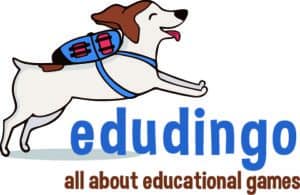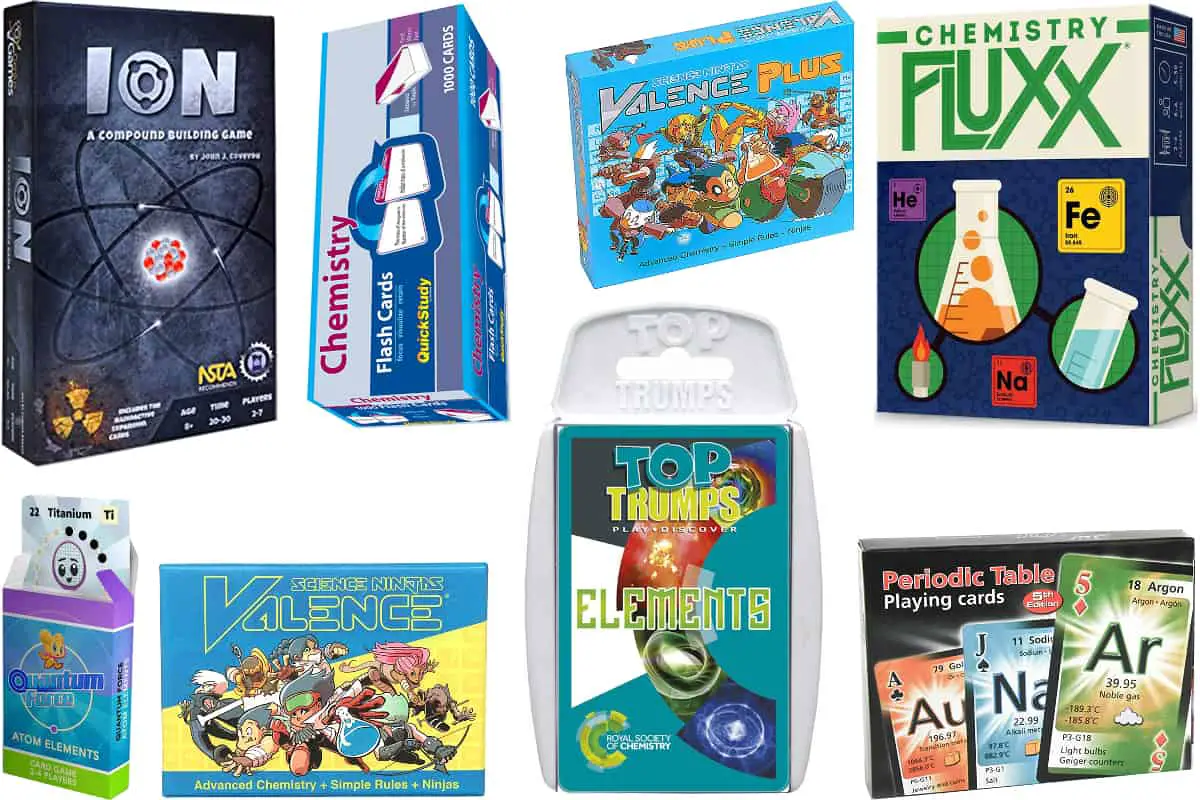This post contains affiliate links.
Chemistry is a complex subject for many students, and it doesn’t have to be that way. So here I’m sharing 14 chemistry card games to make learning about chemistry concepts more accessible and fun.
I found 14 chemistry card games for middle and high schoolers to help them master the subject more easily. These card games cover a lot of different chemistry topics, including:
- Elements and their properties
- Chemical compounds and their formula
- Molecular geometries
Chemistry Card Games Comparison Table
| Game | Theme | Age | Players | Rating |
|---|---|---|---|---|
| Ion: A Compound Building Game | Build neutral compounds | 10+ | 2-7 | ★★★★★ |
| Atom Elements | Atoms, periodic table | 10+ | 2-4 | ★★★★☆ |
| SlapGas | Atoms, periodic table | 10+ | 2+ | ★★★★☆ |
| Synthesis | Build molecules from atoms | 12+ | 2-8 | ★★★☆☆ |
| Valence | Build molecules from atoms | 10+ | 2-4 | ★★★★★ |
| Valence Plus | Build molecules from atoms | 10+ | 2-4 | ★★★★★ |
| Periodic Table Playing Cards | Atoms, periodic table | 10+ | 1+ | ★★★★☆ |
| VSEPR Hold ‘Em | Molecule shapes | 14+ | 2+ | ★★★★★ |
| Chemistry Fluxx | Chemistry concepts | 10+ | 2-6 | ★★★★☆ |
| Chemistry Flash Cards | Chemistry concepts | 10+ | 1+ | ★★★★☆ |
| Top Trumps: Elements | Atoms, periodic table | 10+ | 2-6 | ★★★☆☆ |
| Periodyx | Atoms, periodic table | 10+ | 2-10 | ★★★★★ |
| Periodic Table Flashcards | Atoms, periodic table | 10+ | 1+ | ★★☆☆☆ |
| Elements of the Periodic Table | Atoms, periodic table | 10+ | 1+ | ★★★★☆ |
Chemistry Card Games
Ion: A Compound Building Game (Genius Games)
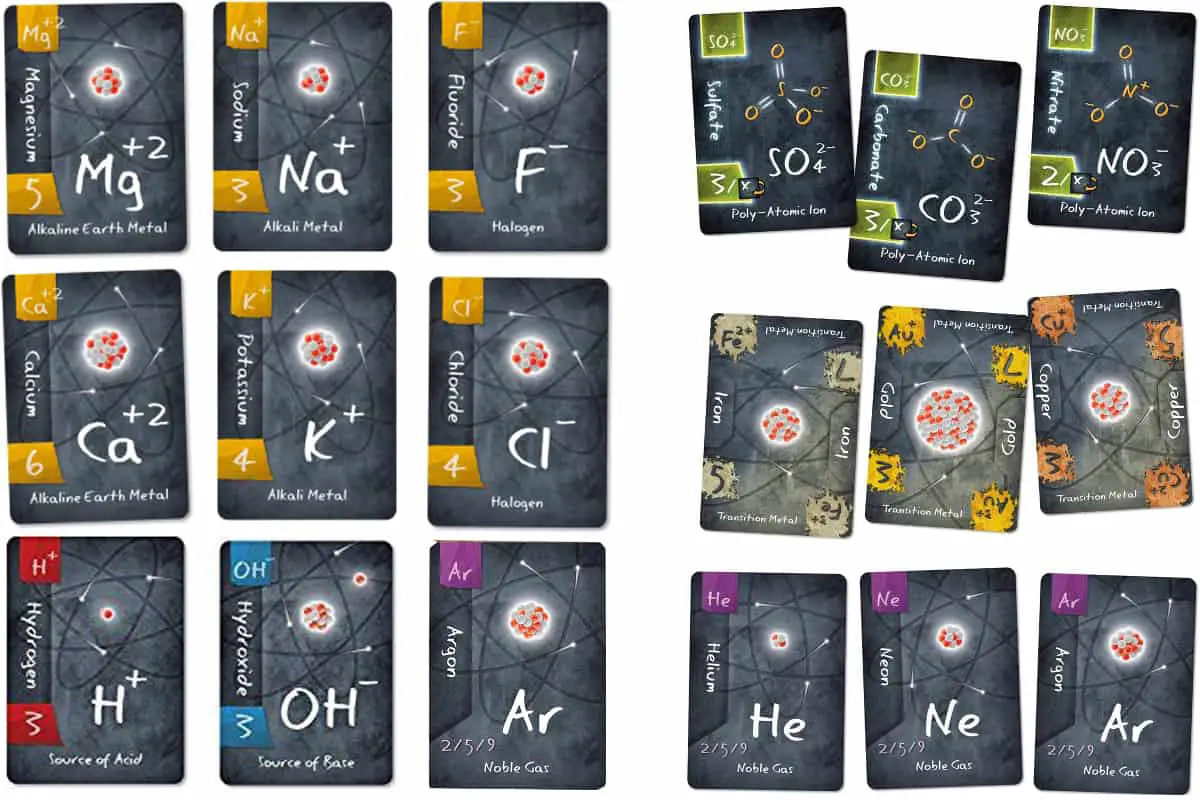
★★★★★
For Families and Schools | Age 8+ | 2-7 Players | Price $$ | Duration 20-30 mins
Ion: A Compound Building Game is a card drafting game where players use ions and elements to form neutrally charged compounds or stable noble gases. This game includes:
is a card drafting game where players use ions and elements to form neutrally charged compounds or stable noble gases. This game includes:
- 9 compound goal cards
- 94 drafting cards
- 21 actions
You can play this game in many ways. To play the simplest method:
- Deal 8 drafting cards to each player
- Each player have to choose a card that they will either set alone or pair with a previously owned card
- After picking a card, pass the whole hand to the next player
- The “pick and pass” round ends when there are only 2 cards left on hand
- Players score their neutral charge compounds and noble gases cards. They also earn more if their compounds match a goal card.
- Repeat these steps for two more rounds, then add all the points to find the winner.
You can also refer to the included rulebook to check out the advanced gameplay, which involves using the action tiles. Another method includes using expansion cards.
I recommend this game for complementing lessons on forming compounds because it simplifies some of the basic bonds that middle school and high school students will encounter in their curriculum. The game also has simple mechanics, so younger children can still use it. Although, they may not really understand what the bonds mean.
Atom Elements (Quantum Force)
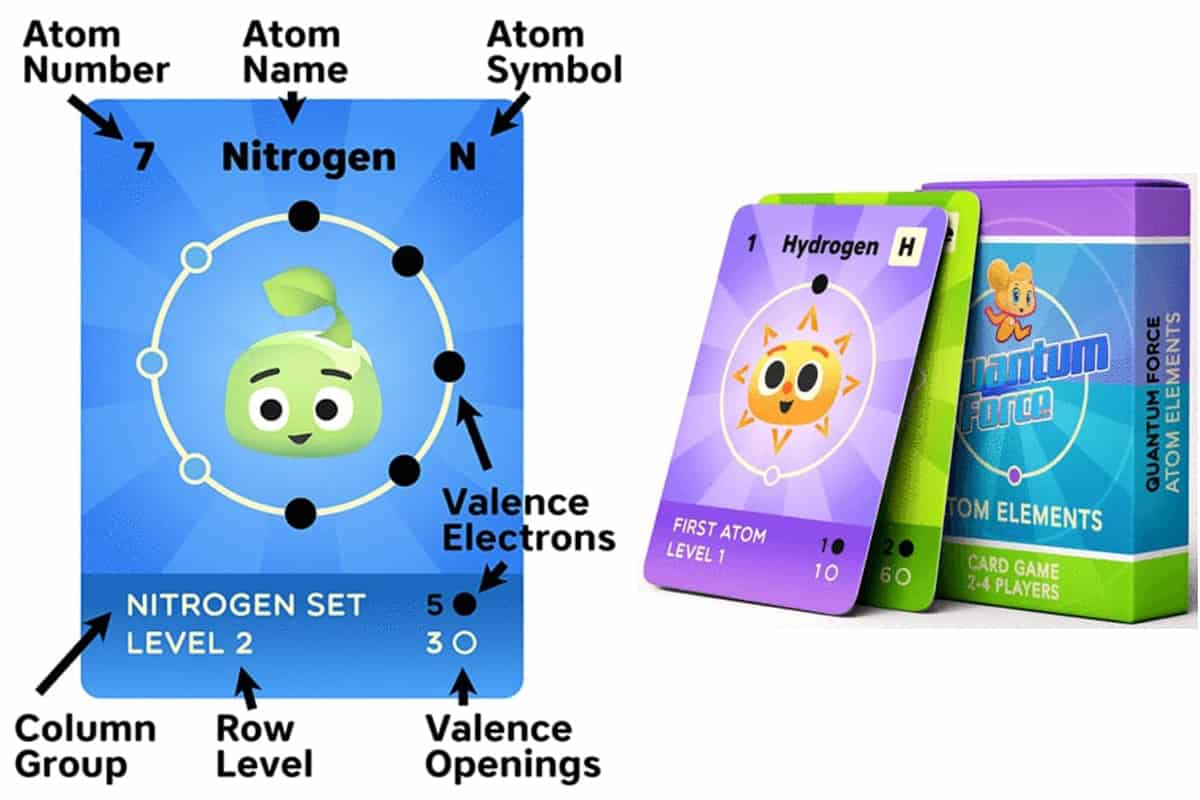
★★★★☆
For Families and Schools | Age 10+ | 2-4 Players | Price $$$ | Duration 20-30 mins
Atom Elements is a cute and engaging card game for introducing the elements of the periodic table. Each card features an illustrated character of the most common way we see the elements. It also includes the following information about the elements:
is a cute and engaging card game for introducing the elements of the periodic table. Each card features an illustrated character of the most common way we see the elements. It also includes the following information about the elements:
- Atomic number
- Element name
- Symbol
- Row-level in the periodic table
- Valence electrons
I like this card game because it features a cartoon image of the elements, making them more exciting and memorable. They also include the key features that children often need to remember to understand the elements. You can use these cards for playing or as flashcards, depending on what your child needs.
I only give four stars to this card game because it does not include all the elements in the periodic table.
SlapGas (Science FUNdamentals)
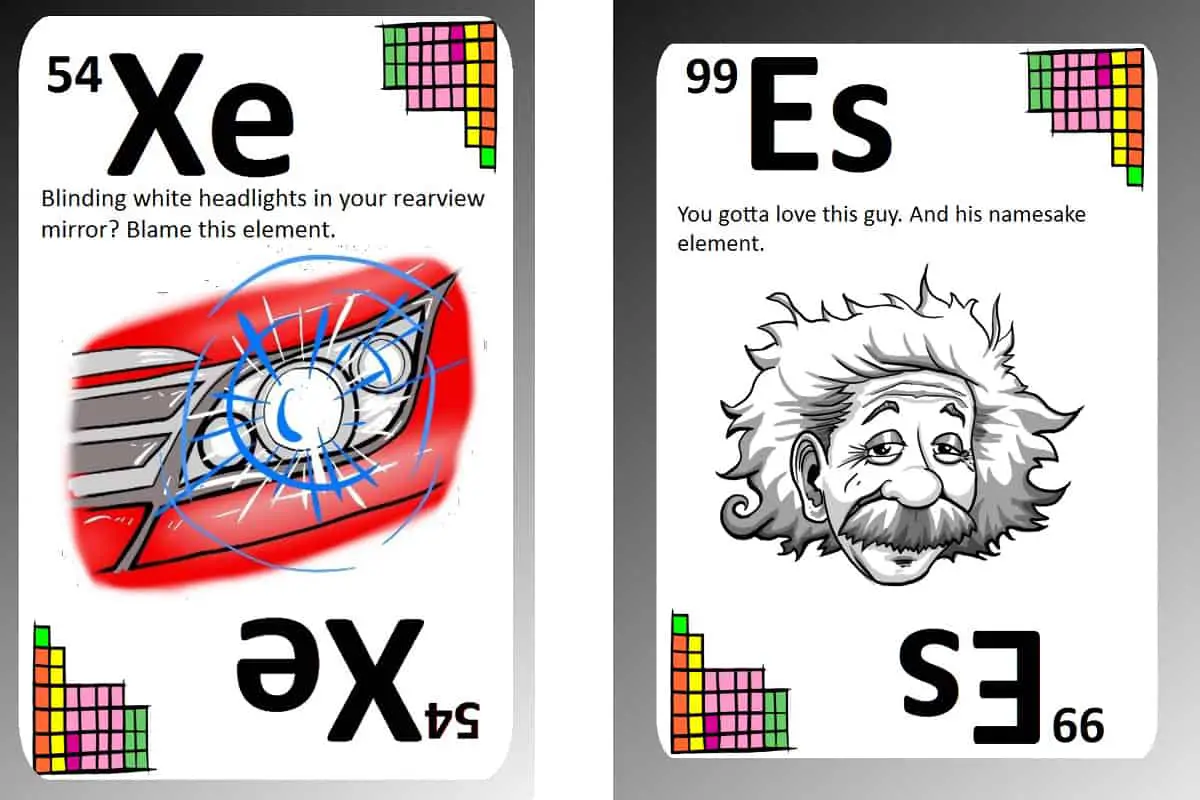
★★★★☆
For Families and Schools | Age 10+ | 2+ Players | Price $$$ | Duration 20-30 mins
SlapGas is a fun chemistry card game inspired by another card game – slapjack. This game features a deck of 118 cards and a copy of the periodic table of elements.
is a fun chemistry card game inspired by another card game – slapjack. This game features a deck of 118 cards and a copy of the periodic table of elements.
The game is as easy to play as slapjack. You only have to:
- Name the element as you take it from the draw pile to the active stack.
- When one of the 11 gaseous elements (hydrogen, nitrogen, oxygen, fluorine, chlorine, helium, neon, argon, krypton, xenon, or radon) is drawn, everyone should slap the card. The first hand on the card wins all the cards underneath.
- The player with the most cards wins.
I like this game because it is really easy to play. And it helps the students remember the elements better. Each card also includes fun element facts to entertain and educate the players.
I only give 4 stars because some facts are not really educational, just fun to read. The pictures also don’t have a consistent theme as some are meant to help you remember the name while others show how the elements are used.
Synthesis (David Fournier)

★★★☆☆
For Families and Schools | Age 12+ | 2-8 Players | Price $$$ | Duration 20-90 mins
Synthesis is a push-your-luck card game featuring the first 20 elements from the periodic table. Each card shows:
is a push-your-luck card game featuring the first 20 elements from the periodic table. Each card shows:
- Element name
- Atomic Number
- Value and mass
- Element symbol
- Valence electrons
- Element type
- Accurate Bohr-Rutherford diagram of the element
To win the game, you must reach the agreed goal score before the other player does. How long a game will last may also depend on how high the goal score is. To achieve the goal score, players have to combine the elements, ions, or molecules and form a resultant. And there are four ways to do this:
- Making eight – combine elements in your hand so that the total valence electrons is 8
- Synthesize an ion or molecule – refer to the requirement listed in the ion or molecule card and combine these elements to form a resultant
- Valence with an ion – combine element/s with an ion on the tableau that has at least one counter on it
- Composition – meet the requirements at the bottom of an ion, molecule, or compound card by using your elements or the ions or molecules with counters on the tableau
This game is appropriate for students who are already starting to learn about combining elements. Although, it can also be used to play just for fun. So even players with no to only a fundamental understanding of the elements can enjoy the game.
I only give Synthesis three stars because there are a lot of rules that you need to understand and remember to actually synthesize. So, there will be a learning curve whenever someone starts playing this game.
Valence (Science Ninjas)
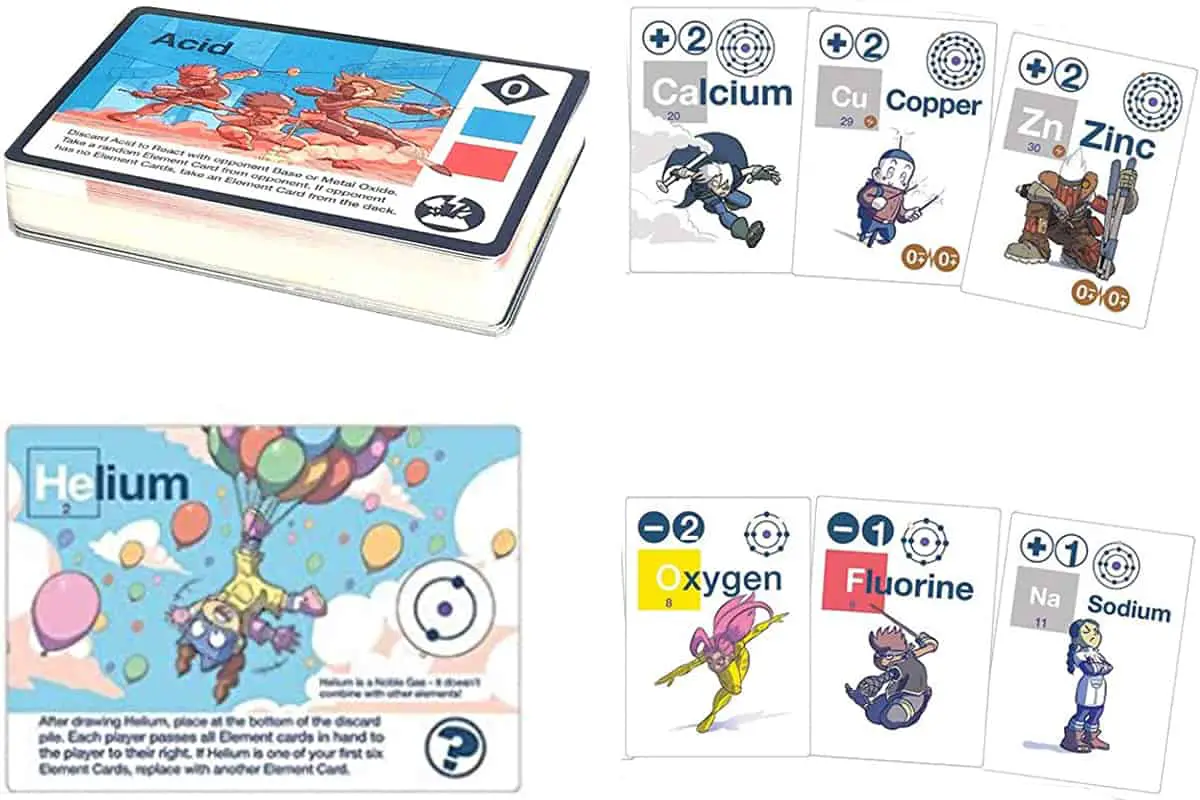
★★★★★
For Families and Schools | Age 10+ | 2-4 Players | Price $$$ | Duration 10-20 mins
Valence is a drafting card game that teaches players how some compounds and molecules are created. The set comes with 48 element cards and 46 molecule cards.
is a drafting card game that teaches players how some compounds and molecules are created. The set comes with 48 element cards and 46 molecule cards.
The main objective of the game is to reach 10 points. You can do this by getting through two phases during your turn:
- Draw phase – you draw a card depending on how many elements you currently have on hand: 1 card if you have 2 or more element cards, 2 cards if you have one, and three cards if you have none
- Build phase – this step is only possible if you have cards with valence numbers that add up to zero. If you do, then you take the matching molecule from the bank and discard your element cards
There are also reaction cards that you can use to take your opponent’s cards or break their molecules.
The game is easy to play and understand. And while the educational aspect is more appropriate for students who are already studying the periodic table of elements, the game can still be played by younger children for fun.
Valence Plus (Science Ninjas)
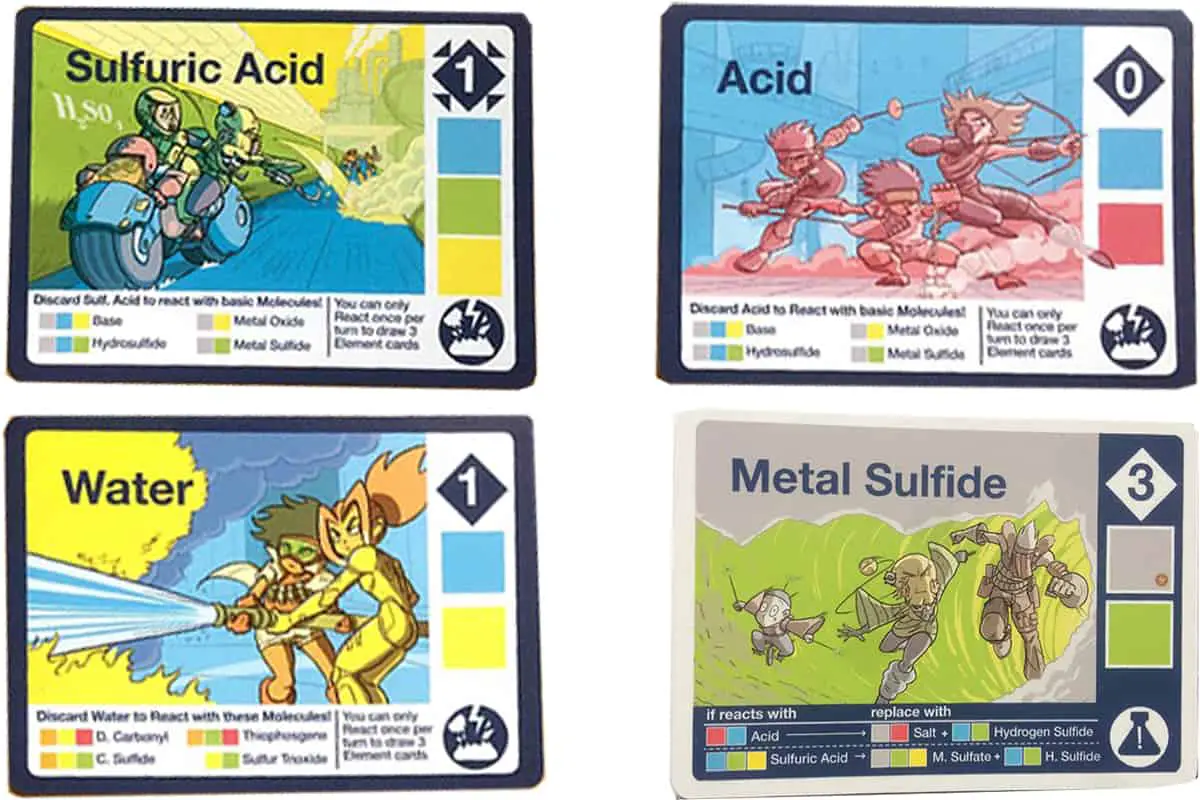
★★★★★
For Families and Schools | Age 10+ | 2-4 Players | Price $$$ | Duration 10-20 mins
Valence Plus is an upgrade to the game mentioned above. It includes more complicated molecules and challenges.
is an upgrade to the game mentioned above. It includes more complicated molecules and challenges.
Instead of only getting 10 points, the game ends when a player reaches 16 points. Then, it follows the same rules as the Valence game. What makes this different are:
- Complex molecules – can only be made as to products of reactions
- Transition metal compound – can block reactions
- Secondary valence numbers – sulfur, zinc, and copper have secondary valence numbers that you can play by flipping the card upside down. However, you can only use them if the requirements in the lower right of these cards are met.
You can also use this set to play with others or independently. The included rule book will help you set up the game whichever way you want to use it.
I like this game because there are different ways to play it, so it has a great replayability. Like the other game, this one teaches the basics of forming molecules, but it can also be played for fun with younger children!
Periodic Table Playing Cards (Les Entreprises SynHeme Inc.)

★★★☆☆
For Families and Schools | Age 10+ | 1+ Players | Price $$ | Duration 10-20 mins
Periodic Table Playing Cards function as both actual playing cards and flashcards. It comes in two sets, covering 104 elements from hydrogen to rutherfordium. The remaining elements are also included as jokers.
function as both actual playing cards and flashcards. It comes in two sets, covering 104 elements from hydrogen to rutherfordium. The remaining elements are also included as jokers.
Each card shows:
- Element name and symbol
- Atomic number
- Series
- Atomic mass
- Name in French and Spanish
- Standard state (solid, liquid, gas, synthetic, radioactive)
- Melting and boiling point in Celcius
- Period group
- Usages
You can use this set as you would use any playing cards. So, your children learn even when they’re not actually trying to when they use these cards. I also like this set because of all the valuable information printed on the playing cards. So, they are really helpful for students who are trying to remember the elements.
VSEPR Hold ’Em (Flinn Scientific)
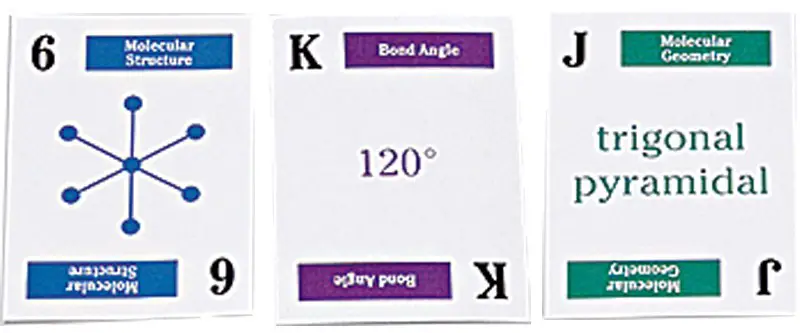
★★★★★
For Schools | Age 14+ | 2+ Players | Price $$$ | Duration 20-30 mins
If you’re looking for games to further explain the valence shell electron pair repulsion (VSEPR) theory, then this card game is great for you. VSEPR Hold ‘Em is a Texas Hold ‘Em-inspired card game that helps reinforce the rules behind the theory. Each set comes with:
is a Texas Hold ‘Em-inspired card game that helps reinforce the rules behind the theory. Each set comes with:
- 5 decks of 44 cards
- Blue, green, and red transparent chips
- Reproducible student handouts
- Teacher notes
I like this set because it includes 5 decks, making it perfect for use in classrooms. It also has a very minimalist design that captures attention and teaches new information. These cards are also designed to fit the Next Generation Science Standards for high school chemistry.
Chemistry Fluxx (Looney Labs)

★★★★☆
For Families and Schools | Age 10+ | 2-6 Players | Price $$ | Duration 10-30 mins
Chemistry Fluxx is an ever-changing rule game with a chemistry theme. This set helps students understand the basics of how elements combine and interact with one another.
is an ever-changing rule game with a chemistry theme. This set helps students understand the basics of how elements combine and interact with one another.
Each set comes with 100 cards in four basic types:
- Keepers – cards that are placed in front of you and help you win a goal; in this set, it can be an element, compound, or lab equipment
- Goals – placed in the center of the table and dictates the necessary keepers that you need to win
- Rules – changes the way the game works and immediately takes effect once drawn
- Actions – single play cards that may or may not affect the entire gameplay
Although the rules constantly change, this game is still easy to play. You only need to follow the rules and the first player to complete a goal win.
I only give this game four stars because while it introduces some basic chemistry concepts, it doesn’t really discuss them further. So, if you will ever use this in class, it cannot really substitute or complement a lesson.
Chemistry Flash Cards (BarCharts Publishing)
★★★★☆
For Families and Schools | Age 10+ | 1+ Players | Price $$ | Duration 10-30 mins
Chemistry Flash Cards is a set of questions for reviewing and learning various chemistry concepts, including:
is a set of questions for reviewing and learning various chemistry concepts, including:
- Elements and their characteristics
- Ion names and formulas
- Compound names and formulas
- Molecular geometries
This set is meant for casual studying. But I think it can also function as a quiz card game in classrooms and homes. Students can take turns asking and answering the questions to check their knowledge or learn new information about chemistry.
I like this set because it has over 1000 numbered cards with detailed problems, questions, examples, and specific answers. The cards also have color-coded tabs per topic for ease of use and organization.
Top Trumps: Elements (Royal Society of Chemistry)
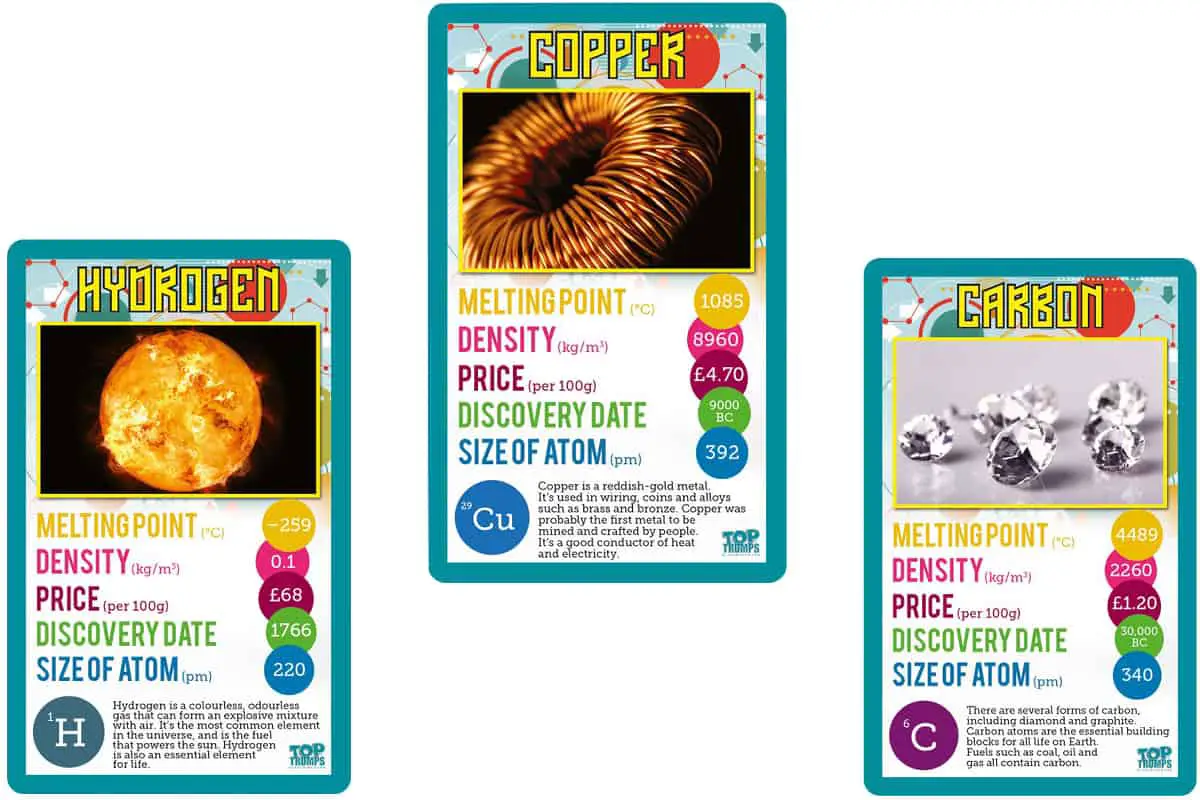
★★★☆☆
For Families and Schools | Age 10+ | 2+ Players | Price $$ | Duration 20-30 mins
Top Trumps: Elements is a fast-paced game featuring important facts about elements of the periodic table. This game comes with 30 cards, covering elements from the first 40 elements in the periodic table.
is a fast-paced game featuring important facts about elements of the periodic table. This game comes with 30 cards, covering elements from the first 40 elements in the periodic table.
This game is similar to other Top Trumps games. You only need to compare the properties of your elements. The cards show:
- Melting point
- Density
- Price
- Discovery date
- Atom size
Then, you have to pick the category where you think you’ll best the other players. I like this game because:
- the rules are easy to follow
- it also requires minimal reading, so even younger children can play this for fun
- it includes additional fascinating facts about each element
While this is a fun game for remembering the characteristics of elements, I only give this 3 stars because there are only 30 cards.
Periodyx (Outset Media)
★★★★★
For Families and Schools | Age 10+ | 2-10 Players | Price $$ | Duration 20-30 mins
Periodyx is a matching and sorting card game where players need to have the best element cards to win the game. Each card has the following information:
- Illustration showing qualities and common uses of the element
- Element name and symbol
- Number of protons and neutrons
- Atomic number
- CAS group number
- Group name
- Phase at room temperature and element classification
- Date discovered
- Atomic weight
- Density
- Melting and boiling point
- Short trivia
- Atomic radius
- Pronunciation guide
The set also comes with a game indicator card that shows what category to play during each turn. I recommend this game because:
- Element cards have colored edges that you can match to make the periodic table of elements
- It features a lot of helpful information about the elements
- There are also icons in each card to indicate toxicity, group, period, and whether it is a natural or synthetic element
- It comes with a detailed instruction guide to help players during their turns
You can also use these cards as flashcards when reviewing the periodic table of elements with your students.
Periodic Table Flashcards (Merka)
★★☆☆☆
For Families and Schools | Age 10+ | 1+ Players | Price $$ | Duration 10-20 mins
Periodic Table Flashcards features the following information about the elements:
- Name
- Symbol
- Mass
- Atomic number
- Chemical family (gas, metal, etc.)
- Illustration showing how or where the element is used
I recommend this game for parents or teachers looking for flashcards with minimal design. This set also features all 118 known elements and is printed in durable paper, which is great for repetitive use. It also has helpful illustrations because they show common uses.
However, I still give this game a low rating because it has very little information included than the other sets in this post. In addition, some of the elements have mislabeled chemical families.
Elements of the Periodic Table (CARDDIA)
★★★★☆
For Families and Schools | Age 10+ | 1+Players | Price $$$ | Duration 10-20 mins
Elements of the Periodic Table is a flashcard set featuring important information about the elements, including:
- Chemical symbol
- Atomic number
- Element name
- Actual picture of common uses
- Electron configuration
- Electron category
- Atomic weight
- Group and block
- Period
- Phase
- Heating and boiling point
I like this set because the front side only shows the chemical symbol, so it is perfect for reviewing the elements and essential details. The cards are also color-coded, depending on their electron category. So, you can also arrange and categorize them with ease.
The only downside of this set is the card’s durability. However, the shop does offer replacements for misplaced and damaged cards.
Other Chemistry Game for Middle School and High School Student
Chemistry is a complicated subject that often intimidates a lot of students. And using games can help make complex concepts easier to digest and remember. It also makes learning about them more engaging and fun. For more game suggestions for your chemistry class, check out 13 Top Chemistry Board Games for Schools and Families !
!
Edudingo.com is a participant in the Amazon Services LLC Associates Program, an affiliate advertising program designed to provide a means for sites to earn advertising fees by advertising and linking to Amazon.com. We also participate in other affiliate programs which compensate us for referring traffic.
